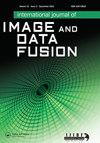UWB positioning algorithm and accuracy evaluation for different indoor scenes
IF 1.8
Q3 REMOTE SENSING
International Journal of Image and Data Fusion
Pub Date : 2021-01-04
DOI:10.1080/19479832.2020.1864788
引用次数: 6
Abstract
ABSTRACT UWB indoor positioning is a research hotspot, but there are few literatures systematically describing different positioning algorithms for different scenes. Therefore, several positioning algorithms are proposed for different indoor scenes. Firstly, for the sensing positioning scenes, a sensing positioning algorithm is proposed. Secondly, for the straight and narrow scenes, a two anchors robust positioning algorithm based on high pass filter is proposed. Experimental results show that this algorithm has better positioning accuracy and robustness than the traditional algorithm. Then, for ordinary indoor scenes, a robust indoor positioning model is proposed based on robust Kalman filter and total LS, which considers the coordinate error of UWB anchors. The positioning accuracy is 0.093m, which is about 29.54% higher than that of the traditional LS algorithm. Finally, for indoor scenes with map information, a map aided indoor positioning algorithm is proposed based on two UWB anchors. This algorithm can effectively improve the reliability and reduce the cost of UWB indoor positioning system, which average positioning accuracy is 0.238m. The biggest innovation of this paper lies in the systematic description of multi-scene positioning algorithm and the realisation of indoor positioning based on double anchors.UWB定位算法及其在不同室内场景下的精度评估
UWB室内定位是一个研究热点,但很少有文献系统地描述针对不同场景的不同定位算法。因此,针对不同的室内场景,提出了几种定位算法。首先,针对传感定位场景,提出了一种传感定位算法。其次,针对直线和狭窄场景,提出了一种基于高通滤波器的双锚稳健定位算法。实验结果表明,该算法比传统算法具有更好的定位精度和鲁棒性。然后,针对普通室内场景,考虑超宽带锚点的坐标误差,提出了一种基于鲁棒卡尔曼滤波器和全LS的鲁棒室内定位模型。定位精度为0.093m,比传统LS算法高出约29.54%。最后,针对具有地图信息的室内场景,提出了一种基于两个UWB锚点的地图辅助室内定位算法。该算法可以有效地提高UWB室内定位系统的可靠性,降低成本,其平均定位精度为0.238m。本文最大的创新在于系统地描述了多场景定位算法,并实现了基于双锚的室内定位。
本文章由计算机程序翻译,如有差异,请以英文原文为准。
求助全文
约1分钟内获得全文
求助全文
来源期刊

International Journal of Image and Data Fusion
REMOTE SENSING-
CiteScore
5.00
自引率
0.00%
发文量
10
期刊介绍:
International Journal of Image and Data Fusion provides a single source of information for all aspects of image and data fusion methodologies, developments, techniques and applications. Image and data fusion techniques are important for combining the many sources of satellite, airborne and ground based imaging systems, and integrating these with other related data sets for enhanced information extraction and decision making. Image and data fusion aims at the integration of multi-sensor, multi-temporal, multi-resolution and multi-platform image data, together with geospatial data, GIS, in-situ, and other statistical data sets for improved information extraction, as well as to increase the reliability of the information. This leads to more accurate information that provides for robust operational performance, i.e. increased confidence, reduced ambiguity and improved classification enabling evidence based management. The journal welcomes original research papers, review papers, shorter letters, technical articles, book reviews and conference reports in all areas of image and data fusion including, but not limited to, the following aspects and topics: • Automatic registration/geometric aspects of fusing images with different spatial, spectral, temporal resolutions; phase information; or acquired in different modes • Pixel, feature and decision level fusion algorithms and methodologies • Data Assimilation: fusing data with models • Multi-source classification and information extraction • Integration of satellite, airborne and terrestrial sensor systems • Fusing temporal data sets for change detection studies (e.g. for Land Cover/Land Use Change studies) • Image and data mining from multi-platform, multi-source, multi-scale, multi-temporal data sets (e.g. geometric information, topological information, statistical information, etc.).
 求助内容:
求助内容: 应助结果提醒方式:
应助结果提醒方式:


